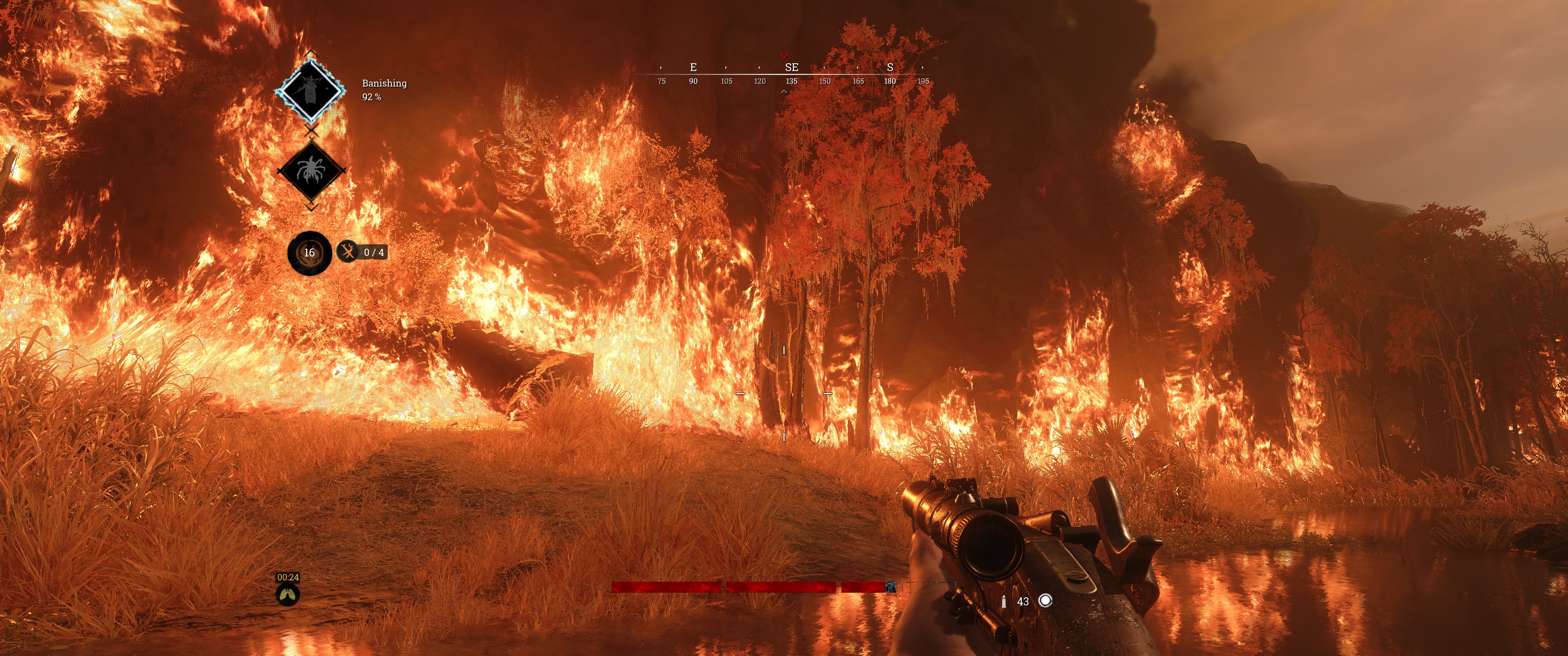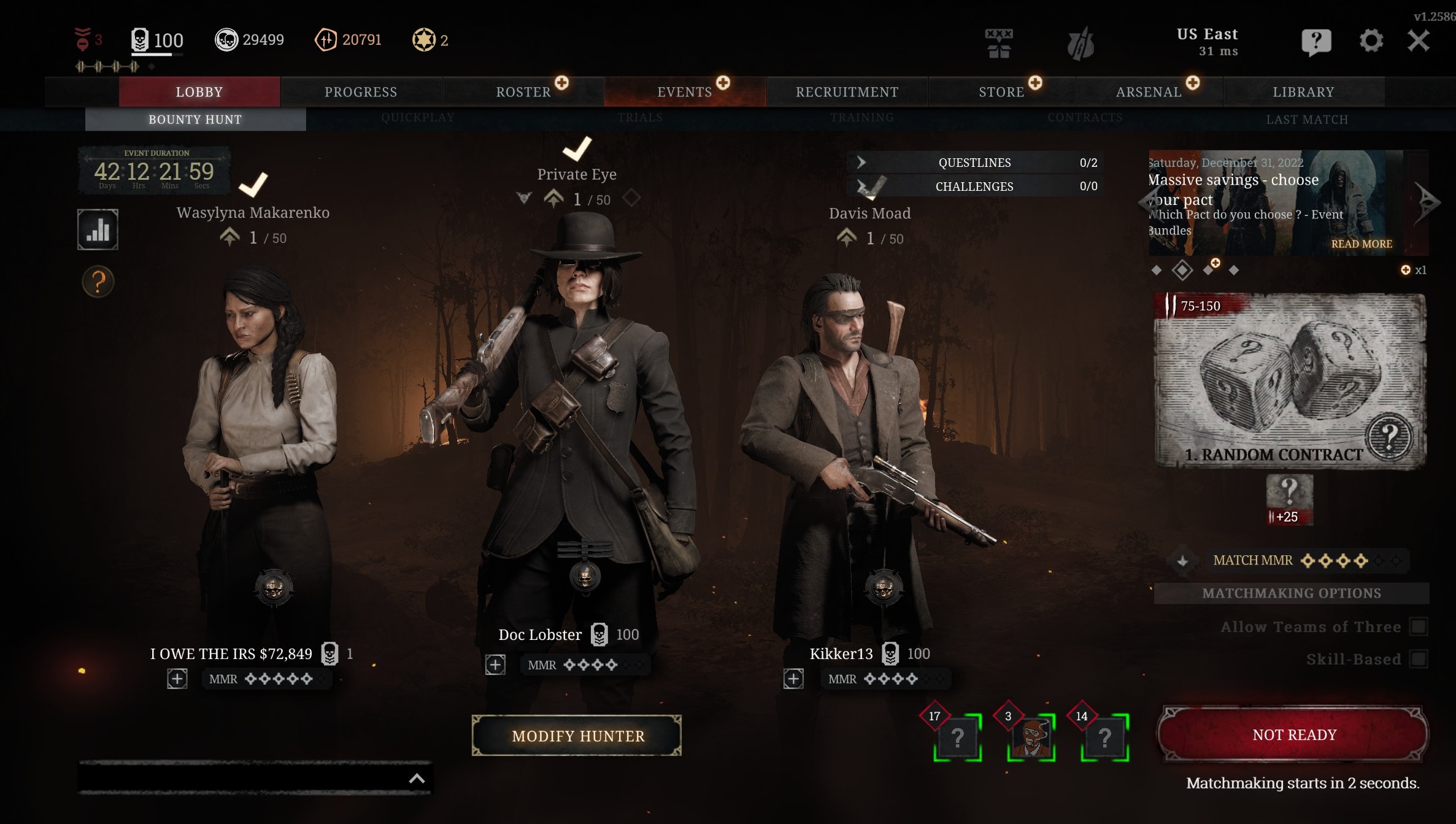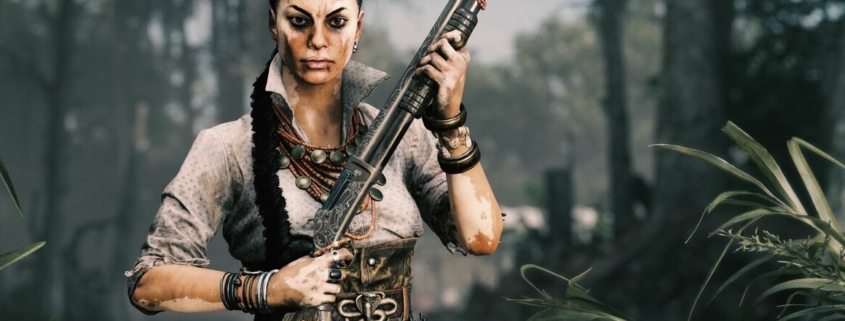Hunt: Showdown is 5 years old, and it’s still the most interesting FPS in gaming
“The exquisite tension of the pervasive unknown,” is how general manager David Fifield describes Hunt: Showdown in a sentence.
Fifield joined Crytek two years ago after working on huge games like Halo and Call of Duty but fell in love with Hunt, determined to work on this weird, swampy multiplayer FPS. “The atmosphere is moody and forlorn, the landscape is corrupted and threatening, the tension builds with every step that you take, every noise that you hear… and that just keeps building and building, far longer than a typical shooter lets that build up before it just breaks into a gunfight.”
Anyone who’s stepped into Hunt knows exactly what Fifield is talking about. When it launched into early access five years ago, it made a strong impression by putting you in a hostile setting with disturbing AI monsters and other players, giving you cowboy-era technology to deal with them. That core experience has remained intact. In its three maps, plentiful overgrowth—maybe the most in the genre—obscures sight lines and makes it possible to stage authentic ambushes. Listening is a rich skill within Hunt, with even a snapping twig in the woods being a helpful source of information. Half a decade later, its emphasis on atmosphere, audio-visual fidelity, and gritty gunplay set it apart from other shooters.
When it first launched, we were still learning the phrase for its format: “extraction shooter.” Competing teams of one, two, or three players, fighting over bounties and racing to “extract” while dealing with AI enemies… There wasn’t much precedent for this sort of thing when Hunt arrived. Battle royale games emerged at the end of 2017, but they pitted humans against each other and forced them into confrontation. Escape From Tarkov had been released only the year before but its modern military world was a far cry from Hunt’s 19th century. A choice that gives the game more than just a distinctive look.
“That tension is amplified by the time period. Weapons have these complex reload animations and period-accurate mechanisms,” Fifield explains. “I gotta make every shot count because if I run out of these bullets, it takes a long time to reload, it’s clunky and I’m vulnerable.” It’s the old technology that draws out every encounter and makes all sorts of weapons viable. Running at an enemy with an axe is a fair strategy when one miss will leave them open to a killing blow. Even the anachronistic weapons are rooted in the period. Of the Bomb Lance, one of Hunt’s more outlandish weapons (essentially a spear that can shoot dynamite), Fifield says, “Well, the technology to do this was there… it’s like combining a little bit of peanut butter and chocolate to make a period-accurate weapon that did not exist.”
Another key piece of Hunt’s character are its supernatural AI enemies, an army of the dead and cursed that rarely kill you, but play a crucial role as resource-eaters, noise-emitters, and chaos-causers. The shambling figures add to the sense of decay that pervades every inch of Hunt’s maps. A lot of ongoing multiplayer games want to (understandably) build colourful, welcoming spaces. Fortnite is a cartoon melting pot, Apex Legends stages a bright sci-fi frontier for its heroes. But here in the bayou, you have to step over dead horses. Otherworldly beasts turn barns and mines into their dens.
That atmosphere isn’t carried by the aesthetics alone. “I absolutely believe Hunt’s audio is world class,” Fifield tells me. I agree—this is one of the rare games you can win with your ears. A rustle of a bush, the wail of a horse, a single footstep, anything can be the thing that gives away a foe and saves your life. A recent patch tweaked gunfire in underground locations, muffling it to make it easier to distinguish from open-air fire. It’s the ambient noises that sell it all though, the buzz of insects or the cries of monsters hidden from sight provide an unnerving din. The seasonal-event wildfire that was running in Hunt over the last two months wasn’t just a sky-high firestorm that players had to move around, the blaze swallowed up sound with its deafening crackle, a sort of sound hazard that you could exploit. 
In almost all of these design decisions, what keeps me coming back to Hunt year after year is the way it arranges these threats, resources, and systems in the environment and steps back, giving players the agency to decide what to do with them. There’s no artificial force pressuring players into confrontation, and your best performance of an evening might be three kills in a match. Maybe you survive against another team by the skin of your teeth and decide to call it a day. As Fifield points out “there is no shrinking circle, no deathmatch respawn, people aren’t sprinting around,” so you’re free to play the game in a myriad of ways and that means your enemies are wildly unpredictable which keeps things fresh, even after years of playing it.
Yet if there is one vital ingredient Fifield feels an extraction shooter lives or dies by, it’s fairness. Or rather, the lack of it. “You have to embrace that it’s not necessarily fair […] One of us is going to live or die and that might be the person with the better gun or it might be the person with the worse gun.” Hunt’s weapons are much more asymmetrical than its modern-military counterparts, and their quirks, in addition to making selecting your loadouts a risk/reward choice. One of the game’s most expensive rifles is the anachronistic Avtomat, a functionally automatic rifle variant. It’ll cost you over a thousand bucks and yet, when you’re holding one, you often feel more fragile, afraid of losing it to a more careful player wielding a $57 bow.
“I absolutely believe Hunt’s audio is world class.”
“We don’t have any body armor, we don’t have shields. Flesh and bone is super vulnerable to a lot of basic weapons and so that lethality, puts at risk all those expensive things you bring in because one headshot and you’re going down.” It’s this vulnerability that makes it all the more meaningful when a lowly “whiteshirt” pulls an expensive Mosin Sniper off the corpse of an experienced and wealthy player.
New Old West
Though it can be played aggressively, Hunt asks more patience from its players than most of its peers in multiplayer FPS, particularly the kill-die-repeat track meet of Call of Duty. That intricacy can make it harder to explain and harder to learn. It also helps explain why the game, after five years, is getting steadily more popular. Through word of mouth, Hunt is steadily finding the people who appreciate its details. “We keep breaking all our records [for player numbers] every event, we keep getting more people in and more people stay,” Fifield says.
One small but significant way Hunt has kept my attention is the surprising diversity of its hunters. It’s not atypical for games of this ilk to forego the inclusion of women or people of different races, often under the guise of historical accuracy. But Hunt: Showdown’s legendary hunter lineup includes Chinese men and women, First Nations peoples, and other characters that more explicitly nod to the game’s basis in North American history. It makes perfect sense to me that Hunt’s world is as diverse as the real America of the time would have been. “
It’s absolutely a deliberate goal in our process,” Fifeld confirms. “When people look at a lot of media, if they don’t see familiar faces or a thing that resonates, they’ll say ‘yeah, that’s not for me.'” To Fifeld, inclusion is part of the game’s narrative. “It fits with our secretive themes, the “untold tales of unsung heroes,” so when we include traditionally marginalised groups and we put them in heroic or aspirational contexts, that’s very woven into Hunt’s DNA.” Doing right by those groups is always an ongoing process for the team. “The First Nation groups that we brought in, we tried to be as respectful as we can, we constantly have discussions about what’s representation over appropriation, we then also talk to sensitivity readers from these different groups.”
Where does Hunt go from here? A priority now is helping new players get on board more smoothly. “We’re working on improving the tutorial and having a more scripted tutorial with more explanations and what we would say is just better teaching than the existing training missions.” Players can expect that very soon according to Fifeld. Further ahead the game is set to be upgraded to the latest version of CryEngine (opens in new tab). “It currently runs on a legacy version from four years ago so one of our major talking points across 2023 is gonna be about updating to the latest 5.11 version. So that’s going to bring some gameplay and graphical enhancements.” Though doing so is going to take a long time and players shouldn’t expect that in the near future.
Though the truth is, for me, Hunt could never change and I would still keep coming back. Crytek ended 2022 with its most interesting seasonal event ever, but the game’s nucleus remains as captivating now as when I first visited the bayou as a terrified idiot who ran around the swamp with a flashlight, one of the least-used items in the game. Hunt’s relative complexity may make it feel impenetrable to players who tried it in 2019 or 2020 once and had no idea how to survive. Over time though, as experienced players speak its praises and offer advice, word of mouth has slowly drawn in more and more people who want something different from their multiplayer experience.
“We don’t even know what our peak is,” Fifeld says with excitement, as the game’s audience has never stopped growing. With the plans to transition to a newer version of its engine, it’s clear Hunt won’t be replaced by a sequel, that Crytek still sees new potential in the game’s second era.




